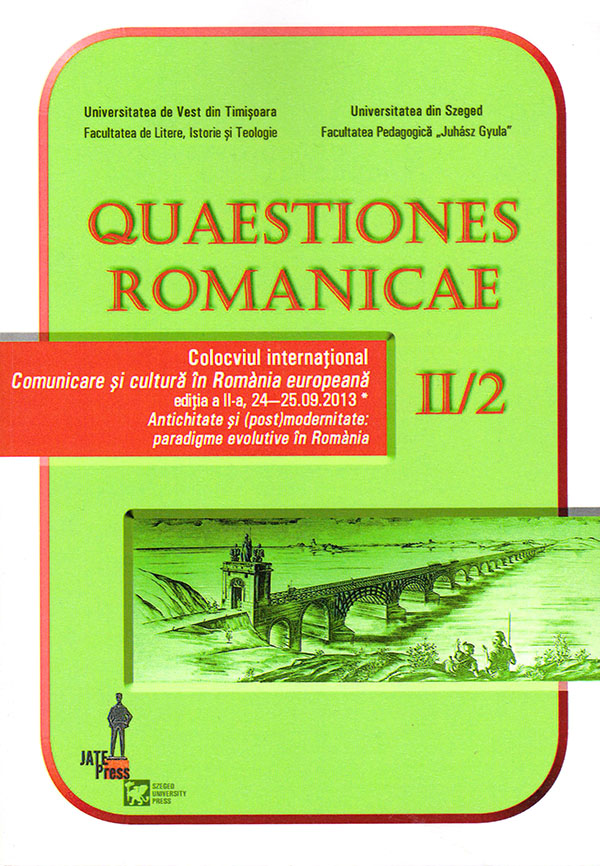Atributul circumstanţial – un simplu subtip al atributului?
Abstract: (The Adverbial Attribute – A Simple Subtype of the Attribute?) Considered for a long time a simple subtype of the isolated Attribute, the Adverbial Attribute represents a yet more complex syntactic function, continuing to cause various controversial issues (at least in Romanian language). Being a cumulative syntactic structure, it is often studied as a double subordinated position to different parts of speech (a nominal one, being the reason why it is mostly considered an attributive determination, and a verbal one, to which it subordinates as an Adverbial – hence, the designation: atribut circumstanţial/AdverbialAttribute. This subordination to a nominal phrase is an obvious one, formally reified by the grammatical agreement, while the second one (to a verbal phrase) is weaker, mediated by the subordination to the nominal, so that many linguists are still simply considering this syntactic category nothing but a subtype of the Attribute. Although weak, this subordination to a verbal phrase can develop various adverbial meanings (cause, concession, consequence, condition, time etc.). Therefore, the fact of the double subordination of the Adverbial Attribute cannot be denied, the distinction between this type of Attribute and the proper Attribute being obvious. As a proof, the Adverbial Attribute has been studied as a Predicative Adjunct of the Double Predicate/predicativ suplimentar, a definitely double subordinated structure – moreover, the Romanian Predicative Adjunct of the Double Predicate had been called this way, a long while. The Adverbial Attribute can also be a clause structure (also double subordinated), a phenomenon that can mostly be explained by the correspondence between a phrase (having a particular syntactic function) and a subordinate clause (having the same function as the phrase). We consider that the Adverbial Attribute does not represent only a simple category of the isolated (explanatory) Attribute, as it is described in most academic papers, and that it is certainly a type of the double subordinated syntactic structures. Agreeing with this, we can also avoid many possible confusions and syntactic ambiguities. Thus, the Romanian syntactic system is enriched with a new syntactic category, different from the others, especially from the similar ones, that can often create numerous confusions (the proper Attribute, the Adverbial and the Predicative Adjunct of the Double Predicate).
Keywords: Attribute, Adverbial, double subordination, Predicative Adjunct of the Double Predicate, syntactic function.
Rezumat: Considerat multă vreme un subtip al atributului izolat, atributul circumstanţial este încă o funcţie sintactică mult mai complexă, cu un statut care continuă să işte multiple controverse, cel puţin în gramatica limbii române. Fiind un cumul de valori sintactice, este considerat adesea drept o poziţie sintactică dublu subordonată faţă de regenţi diferiţi din punct de vedere morfologic (unul nominal, motiv pentru care este mai ales o determinare atributivă, şi unul verbal, cu care stabileşte un raport circumstanţial – de aici, denumirea de atribut circumstanţial). Legătura cu regentul nominal este una vădită, concretizată la nivel formal (prin acord), în timp ce relaţia cu verbul regent este una slăbită, mijlocită de raportul cu nominalul regent, fapt pentru care mulţi lingvişti continuă să considere această categorie sintactică un simplu tip de atribut. Deşi slabă, această relaţie cu regentul verbal poate dezvolta multiple sensuri circumstanţiale (cauzal, concesiv, consecutiv, condiţional, temporal etc.). Aşadar, realitatea dublei subordonări faţă de doi regenţi diferiţi a atributului circumstanţial nu poate fi negată, iar distanţarea sa de categoria atributului este evidentă. Drept dovadă, atributul circumstanţial a fost şi continuă să fie interpretat drept predicativ suplimentar, funcţie sintactică dublu subordonată prin definiţie – mai mult chiar, de-a lungul timpului, predicativul suplimentar a fost adesea denumit cu această sintagmă. Atributul circumstanţial cunoaşte şi realizări frastice (tot dublu subordonate), fenomen explicabil mai ales prin corespondenţa dintre o parte de propoziţie şi o propoziţie subordonată. Considerăm că atributul circumstanţial nu constituie o simplă subcategorie a atributului izolat (explicativ), cum este descris în majoritatea lucrărilor academice, şi că se înscrie, pe bună dreptate, în clasa funcţiilor sintactice cu dublă subordonare faţă de regenţi diferiţi. Recunoscând acest fapt, putem, de asemenea, evita numeroase confuzii care se pot crea la nivel sintactic. Astfel, sistemul sintactic românesc se îmbogăţeşte cu încă o funcţie de sine stătătoare, independentă de alte categorii sintactice cu care prezintă multiple similitudini şi cu care este adesea confundat (atributul, complementul circumstanţial sau predicativul suplimentar).
Cuvinte-cheie: atribut, circumstanţial, dublă subordonare, predicativ suplimentar, funcţie sintactică.
